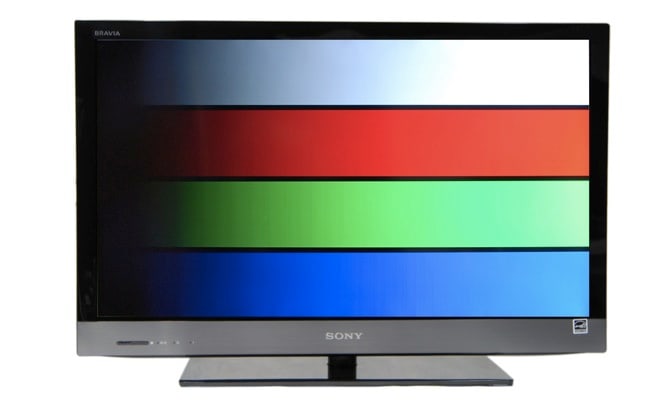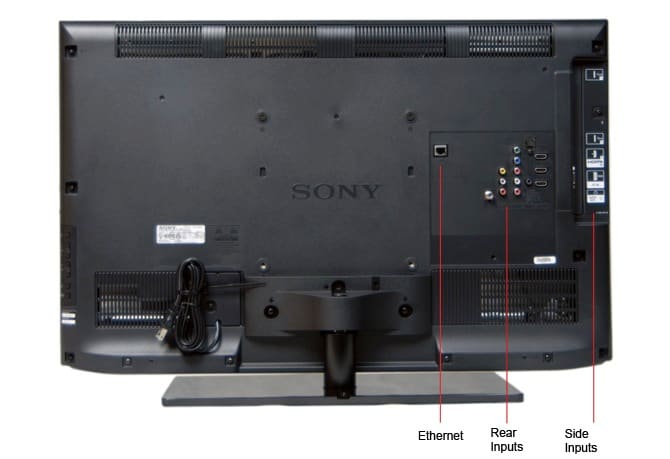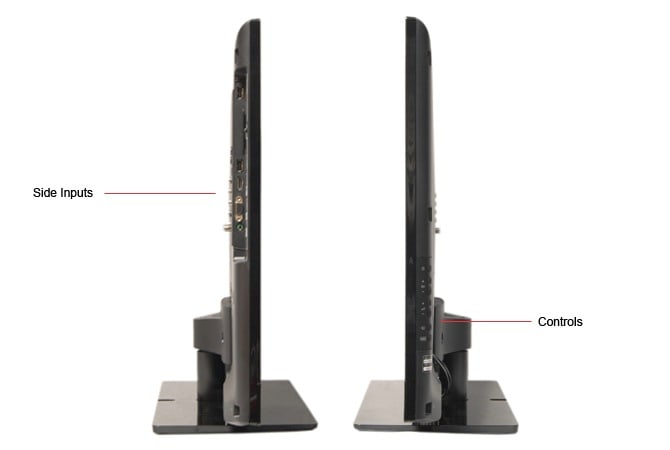Introduction
Tour & Design
The KDL-32EX520 features a glossy black plastic bezel with a brushed aluminum-style accent across the bottom of the unit. The accent strip is highly reflective and interrupts the set's otherwise clean lines. There are no controls on the front of the set, but three indicator lights and a remote control sensor stick out like sore thumbs against the metallic backdrop. Though the design may work for a larger set, on such a small TV it comes across as cluttered and distracts from the actual display.

The back of this Sony HDTV is a swath of inexpensive-looking matte black plastic with a small, glossy Sony logo in the center. When looking at the set from the rear, controls are on the left, the power cord comes from the center and input/output ports are on the right. For information about the ports on the back of the Sony KDL-32EX520 see our Connectivity section.

As an LED-backlit LCD, the KDL-32EX520 is decidedly svelte. Still, Sony managed to fit a slightly recessed set of ports on the set's left side. This is an ideal design for those who want the accessibility of side-mounted ports but don't want their HDTV to have a bundle of wires protruding directly from the side of the set. On the right are labels for the rear-mounted controls. For information about the ports on the sides of the Sony KDL-32EX520 see our Connectivity section.

The stand came in three parts that were easily assembled, though you'll need your own screwdriver. The display sits on a pole, which fits into a heavy base. When assembled, the display swivels 20 degrees in either direction. It's a nice perk, though for a TV this compact and light such a feature is hardly a necessity.
On the rear of the set, there are holes where the HDTV can be attached to a wall mount.
This HDTV has basic controls on its right side. They're small buttons, though the rockers for volume and channel are evenly spaced and distinguishable by touch. We wouldn't recommend using the on-board controls to make any big changes, however. The Byzantine menu structure on this Sony is best navigated with a remote whose dedicated buttons make quick work of exiting the fourth layer of a submenu.
We're not fans of the KDL-32EX520's remote control. Inexplicably, the extremely wide controller has a concave top and a flat bottom, which makes it extremely uncomfortable to hold. AAA batteries give it little balance at the base, and comfortably switching between keypad and volume require shifting your grip. Aside from menu and navigation keys and the rockers for volume and channel, the remote is a sea of small rectangles indistinguishable to the human finger. We'd say to replace this one with a universal controller as soon as possible, but the multiple proprietary features could be confusing to navigate on a budget universal remote.
This HDTV comes with a stand, remote, batteries and user manual. You'll need a Phillips screwdriver to put it all together.
Blacks & Whites
The KDL-32EX520 did a great job displaying black, with a black level of 0.05 candelas per square meter (cd/m2). An acceptable black level is anything below 0.20 cd/m2, so this Sony's performance means the color black on screen will display very close to a true black. One setting that could not be turned off was an auto-dimming feature that kicked in when the display faded entirely to black. Still, we were able to accurately test the Sony before it dimmed. (More on how we test Black Level.)
After turning off all "Eco" power-saving settings, the Sony still only managed a peak brightness of 231.67 cd/m2. Any display with a peak brightness over 200 cd/m2 won't wash out on a sunny day or in a bright room, but the KDL-32EX520's relatively low reading means it will appear dimmer than competing sets. (More on how we test Peak Brightness.)
The KDL-32EX520's excellent contrast ratio is largely due to its exceptional black level. We measured a contrast ratio of 4633:1 with all specialized video processing modes turned off, which puts it well ahead of the competition in this regard. That means this Sony will do a good job maintaining detail displaying scenes set in shadow, which is good news for fans of horror flicks and all flavors of Law & Order. (More on how we test Contrast.)
Like most LCD televisions, this Sony HDTV had no problem displaying a consistent black even while the rest of the screen turned a bright white. Plasma sets can have some difficulty displaying an even black as the rest of the screen gets brighter, but LCDs tend to do well on this test. At an all-black screen, the black level changed. This is likely due to an auto-dimming setting on the set that cannot be turned off. We feel that users should have full control over their television's settings, but obviously Sony sees things differently. (More on how we test Tunnel Contrast.)
Again, it's not surprising that the KDL-32EX520 did a superb job in the white falloff test. Plasma TVs usually have some trouble with this test. In order to avoid overheating, they have to tone down the overall brightness of white as more of it is displayed on screen. LCDs, on the other hand, have no such issues. (More on how we test White Falloff.)
This LED-edgelit HDTV didn't fare so well in uniformity tests, especially when displaying black on screen. It's clear that the LCD screen is illuminated from the edges, as the corners of an all-black screen appear dramatically brighter than the rest of the display -- a phenomenon known as flashlighting. This is less noticeable on an all-white screen. (More on how we test Uniformity.)
Greyscale gamma measures how well a set differentiates among shades of grey between the darkest black and the brightest white. An ideal slope of a greyscale should be around 2.1. The KDL-32EX520 does a better job than similar LCD TVs at this task, but will still have some trouble showing transitions between colors. For example, watching Law and Order, we saw some posterization looking at the lawyers' dark suits. (More on how we test Greyscale Gamma.)
Color Accuracy
The Sony KDL-32EX520 did remarkably well maintaining a nearly perfectly consistent color temperature when it came to bright whites and midtones. It had some trouble displaying the deepest blacks, but you most likely won't notice it. (More on how we test Color Temperature.)
The KDL-32EX520 also did a great job in our color representation test. The very small bumps in the lines indicate a small amount of color banding, which is the only problem we can see here. Still, none of the lines peaked too early, and the curve is very smooth in comparison to this HDTV's competitors. (More on how we test RGB Curves.)
Below, we've posted some gradient strips that show exactly how the Sony KDL-32EX520 reproduces color in comparison to similar sets. Obvious vertical blocksare a sign of color banding, meaning that a set doesn't do a good job differentiating between two close-together shades of a same color. A gradient that turns black earlier than the ideal response signifies a set where detail will be lost in dark scenes.
The KDL-32EX520 didn't do the best job accurately displaying colors to the rec. 709 international standard. Reds were slightly oversaturated, while blues weren't vivid enough. (More on how we test Color Gamut.)
If you want to crunch the numbers yourself, here they are:
Motion
The KDL-32EX520 proved the first law of 60Hz displays: an object in motion stays blurry even when video processing modes are enacted upon it. Motion performance on this Sony was sub-par, with moving images noticeably losing detail and color to blur in both the native 1080p and 1080i resolutions. For instance, in a photo of a fireplace, the white mortar defining the red bricks disappeared into a murky, pinkish mess as the image began to move across the screen. You probably won't be watching too many moving fireplaces, but the NBA playoffs will suffer the same fate. Similarly, artifacting was a problem on this Sony, turning lines that appeared vertical at standstill into jagged lightning bolts in motion. (More on how we test Motion.)
The Sony can certainly process film content shot at 24 fps using its 3:2 pulldown feature, labeled CineMotion. However, the KDL-32EX520 does only an adequate job. For example, slow, horizontal pans across a landscape stutter instead of displaying smoothly. (More on how we test 3:2 Pulldown and 24fps.)
While the KDL-32EX520 has a native resolution of 1080p (1920 x 1080), you'll probably be watching content in all different resolutions. That's why we test HDTVs to see how well they process and display content in non-native resolutions. On this set, you should have no problems watching all kinds of content, from old episodes of Murphy Brown to the latest Blu-Ray discs. Though certain resolutions suffered from overscan, the display of this Sony can be manually corrected to better process such images. (More on how we test Resolution Scaling.)
480p
The former resolution standard lost 3 percent of the picture horizontally and vertically. Text was legible, though it's easier to read when displayed at higher resolutions.
720p
At 720p, the Sony lost 3 percent of the picture at each side and top and bottom due to overscan.
1080i
At 1080i, the display was cut by 2 percent at the top and bottom and at both sides.
Viewing Effects
The KDL-32EX520 has a native resolution of 1080p, and can display other formats with no problem.
Most LCDs are difficult to view from extreme angles. However, the KDL-32EX520 was especially problematic in this respect. Viewers sitting more than 20.3 degrees from perpendicular to the set could only see a picture that's lost more than 50 percent of its contrast. If the set is directly opposite the foot of a bed, that kind of a limited viewing angle won't be a problem. But if you're planning on watching a movie with a large group, expect lots of people crowded in front of the screen. (More on how we test Viewing Angle.)
Though any TV will have difficulty maintaining a good contrast ratio in extreme brightness, external light sources tended to wash out the display of the KDL-32EX520. On a dark screen, a small rainbow pattern radiated from where the light source hit the screen and distracted from the image being displayed. Targeted bright lights -- meant to simulate an overhead or floor lamp -- showed on screen as a wide glow. (More on how we test Reflectance.)
The KDL-32EX520 has a number of video processing modes. While some don't change displayed images at all, others simply appear to increase or decrease sharpness, color or contrast.
Calibration
[

](http://www.displaymate.com/)With the exception of backlighting, the KDL-32EX520 came out of the box fairly well calibrated. The "Warm 2" setting gave us a color temperature around 6500 Kelvin, and most advanced picture controls were turned off. Other settings were somewhat confusing: "Picture" seemed to control brightness, while "Brightness" controlled contrast. In addition to tweaking picture settings, we turned off all power-saving functions, and that move significantly brightened the display.
Confusingly, some menus follow entirely numeric scales while others have numbers in the middle but beginning and endpoints of "Min" and "Max," respectively.
In addition to user-customizable picture settings, the KDL-32EX520 also offers preset picture modes and blank settings to save custom picture modes.
Connectivity
The KDL-32EX520 has a plethora of ports, with 4 HDMI inputs, 1 component and 2 composite inputs, 2 USB ports and all the other usual suspects. For those foraying into the world of home theater for the first time, the manual does a good job illustrating the multitude of combinations that can be plugged into the Sony. Oddly, the VGA input is on the side of the TV next to a 3.5 mm output, so you'll need to plug in your PC's audio into the rear of the set.
For internet connectivity, the Sony features an Ethernet jack plus support for the UWA-BR100 WiFi adapter, which can be found in stores for about $80.
The side of the KDL-32EX520 features 1 HDMI port, 2 USB inputs and 1 VGA input. As we already mentioned, there's a headphone jack but no analog audio input on the side of the set. Camcorder and digital camera users may find it inconvenient that there's no component inputs on the side of the set, but a swiveling stand makes it easy enough to access the inputs on the TV's rear panel.
Audio & Menus
The KDL-32EX520's audio is good when compared with similar HDTVs. There's no tinniness to the sound, which is relatively rich considering it's coming from a pair of 10w compact speakers.
Preset selections have ideal settings for talk shows and movies, while an on-board equalizer allows for fine tuning. The surround sound setting offers move vivid audio, but can't compare with a dedicated external system.
The menu interface on the KDL-32EX520 is acceptable. Across features, menu inputs are consistent, and few options are hidden. However, as there are so many functions, it can take a number of button pushes to access a desired feature, and a number of hits to the "return" button to get back to a top menu. The most-changed features are often hidden in the middle of menus, and scrolling down at the end of a menu doesn't get you back to the beginning, so expect tired thumbs from pressing "down" and "up" numerous times on the uncomfortable remote's D-pad.
Picture settings show either half a picture or the entire picture with just a small selection window, which means you can adjust the set's picture while looking at what's being displayed. We like that Sony-specific feature names are explained through brief summaries that appear at the bottom of a menu screen. We don't like that scales and possible selections are confusing and inconsistent. For example, backlight ranges from "Min" to "Max" with a numeric scale in-between.
Though some preset picture modes lock individual settings, it was easy to access detailed picture menus with a minimum of hunting through submenus.
As expected from Sony, the printed instruction manual is well-written with great diagrams. However, it leaves the bulk of instructions to an on-screen "i-manual" and it's in a different format than we've seen from Sony manuals past. Though it contains a table of contents and tabs, it omits an index. You can find the Sony KDL-32EX520's manual online here.
In addition to the printed manual, there's an on-screen "i-manual" that goes into greater detail than the paper/PDF guide.
Multimedia & Internet
The Sony KDL-32EX520 has a LAN port and an option to add WiFi through an external add-on that retails for about $80. When connected, the Sony lets you connect to a DLNA home theater network, surf the internet in a clumsy browser, and use a suite of online streaming apps that are common to Sony sets.
Some, like Netflix and Qriocity, are accessed through dedicated keys on the remote. Other streaming apps -- from yoga poses and health tips from Dr. Oz to Hulu Plus and Amazon Video On Demand -- can be found in submenus. Pandora and Slacker may be fun to put on at parties, but the majority of apps are advertisements or proofs of concept.
We couldn't test the Sony's Qriocity feature, as the entire network was down during our testing period after both it and the PlayStation networks were hacked. However, other apps loaded quickly and setup was a breeze after plugging the TV into a standard router.
This Sony gets points because it hits the trifecta of local media playback: video, audio and photo. Unfortunately, it only features primitive local media playback of certain audio, videos and photos that are loaded onto a USB drive connected into one of the set's two ports.
The media browsers are far from elegant, and only play a few file formats: MP3 and WAV for audio, MPEG video files and .jpg, RAW and MPO photo files. The audio files we tested displayed error messages before eventually playing.
Oddly, though photos previewed in the browser, selecting an individual photo led to an error message. We tried multiple USB drives and many .jpg photos to no avail.
Power Consumption
With the cost of average power consumption totaling $13.97 for this HDTV on an ideal backlight setting, the KDL-32EX520 runs on the expensive side of average among LCDs. Still, it's about a quarter the cost of an energy-hungry plasma. The set does offer several power-saving options, but nearly all of them dim the picture significantly. (More on how we test Power Consumption.)
Interestingly, after the set was turned off it took a few minutes before the KDL-32EX520's power consumption dropped to zero. This may be because the set was automatically downloading software updates. If you're truly that worried about your electric bill, automatic updates can be turned off and run manually when the set is already on.
By comparison, running a similar LCD HDTV would cost between $13.21 and $14.79 each year.
Vs Vizio M320VT
Value Comparison Summary
If you're not looking for internet connectivity, the Vizio M320VT is a worthy competitor to the Sony KDL-32EX520. They're both 32-inch LED-edgelit LCD HDTVs, they both have excellent color performance and the Vizio bests the Sony at viewing angle and motion performance. If it's cost that's most important, the Vizio is also close to $100 cheaper.
Blacks & Whites
Both the Vizio and the Sony had superb contrast ratios. The Sony, however, had a darker peak brightness than the Vizio.
Color Accuracy
Neither the Sony nor the Vizio had any major errors in displaying accurate color temperatures. Any hiccups in color temperature that either set has are outside of the human eye's ability to perceive. The Vizio, however, showed a slight amount of color banding in the RGB curve test.
Motion
The Sony didn't fare too well in the motion processing tests, which would make it a less appealing choice for viewers of sports and action films where moving images constantly cross the screen. The Vizio offers less blur and artifacting, so it wins this comparison.
Viewing Effects
At 38.03 degrees total, the Vizio M320VT has a surprisingly wide viewing angle for an LCD. It's no surprise, then, that the Vizio handily trounces the Sony. Viewers of the KDL-32EX520 get half the viewing angle the M320VT offers before the set's contrast ratio drops below 50 percent.
Connectivity
When it comes to connectivity, the Sony stacks up well against the Vizio M320VT with the notable exception of internet access. The Sony's got it, but the Vizio does not. Otherwise, the Vizio relies on side-mounted ports while the Sony hides them on the back of the set. If you're looking to keep wires out of sight, the Sony may be a better choice.
Vs LG 32LD350
Value Comparison Summary
The LG 32LD350 is an excellent performer for such a low-cost HDTV. In fact, you could save $220 by choosing the LG over the Sony. You'd be giving up internet access and a native 1080p resolution -- the LG has no internet connectivity and is 720p -- but otherwise, the two stack up pretty well. If $629 sounds steep for a 32-inch TV, check out the LG.
Blacks & Whites
The LG's slightly higher black level is no match for Sony's excellent contrast ratio. With a deepest black of 0.05 cd/m2, you'll get better details in shadows from the KDL-32EX520.
Color Accuracy
Both the LG and the Sony performed well in the color temperature and RGB curve comparisons. Any differences between the two sets are too minute for the eye to see.
Motion
The LG does a far superior job at displaying objects in motion than the Sony. Even if the LG hadn't had such solid motion performance, it still would've won this comparison as the Sony's motion processing left a lot to be desired. Blur and artifacting accompanied nearly every moving image during out tests, and even advanced video processing modes did little to help.
Viewing Effects
Though the LG has a slightly narrower viewing angle before is contrast ratio drops below 50 percent, its close enough to the Sony that this comparison is a draw.
Connectivity
Port for port, it's apparent that the LG is a budget set. With two fewer HDMI inputs, no digital audio output and no internet support, the LG 32LD350 is no match for the Sony if connectivity is your main concern.
Vs Panasonic TC-L37D2
Value Comparison Summary
Though the Panasonic has a significantly higher MSRP than the Sony, it can now be found for close to $700 online. For that extra $70, you're getting a larger screen and iPod connectivity, but losing internet connectivity and an LED-edgelit HDTV's slim profile. The Panasonic excels at motion performance, but is far worse than the Sony at displaying color and contrast.
Blacks & Whites
Thanks to an abysmal black level, the Panasonic TC-L37D2 can't compete when it comes to contrast ratio. Without question, the Sony will offer better detail in shadowy scenes.
Color Accuracy
While both the Panasonic and Sony did well displaying accurate color temperatures, the Panasonic had difficulty in our RGB curve tests. After the original review, we re-tested the set and found that no matter what settings are selected, the Panasonic oversaturates midtones and bright colors.
Motion
The Panasonic handily bests the KDL-32EX520 at motion performance, with only faint trailing and artifacting visible on moving objects. The Sony had particularly poor motion performance, so this is no surprise.
Viewing Effects
With a total viewing angle of 48 degrees (24 degrees on either side of dead center), the Panasonic offers a slightly better viewing angle than the Sony, which has a total viewing angle of about 40 degrees. Any plasma will offer a significantly better viewing angle than either LCD.
Connectivity
Comparing the connectivity options of these two HDTVs is a bit like pitting apples against oranges, since the folks at Panasonic do things a little differently. First off, like many Panasonic HDTVs, the TC-L37D2 comes with SD/SDHC support instead of USB inputs. Though that setup may actually be preferable for folks who frequently share slideshows of their latest vacations, it only allows for photo playback. The TC-L37D2 also comes with an included iPod dock. Otherwise, it's nearly identical to the Sony albeit lacking internet access and one HDMI input.
Conclusion
Series Comparison
KDL-xxEX520 Series
The KDL-xxEX520 series contains two other sets, both larger than the 32-inch KDL-32EX520. Aside from more screen real estate, both the 40-inch and 46-inch sets have identical LED-edgelit LCD displays, internet connectivity and similar chassis. All of the sets tout a Picture-In-Picture feature and the X-Reality engine -- Sony's name for its latest video processor.
Meet the tester
Keith was the Editor in Chief of Reviewed's appliance and automotive sites. His work has appeared in publications such as Wired, Car & Driver, and CityLab.
Checking our work.
Our team is here to help you buy the best stuff and love what you own. Our writers, editors, and experts obsess over the products we cover to make sure you're confident and satisfied. Have a different opinion about something we recommend? Email us and we'll compare notes.
Shoot us an email